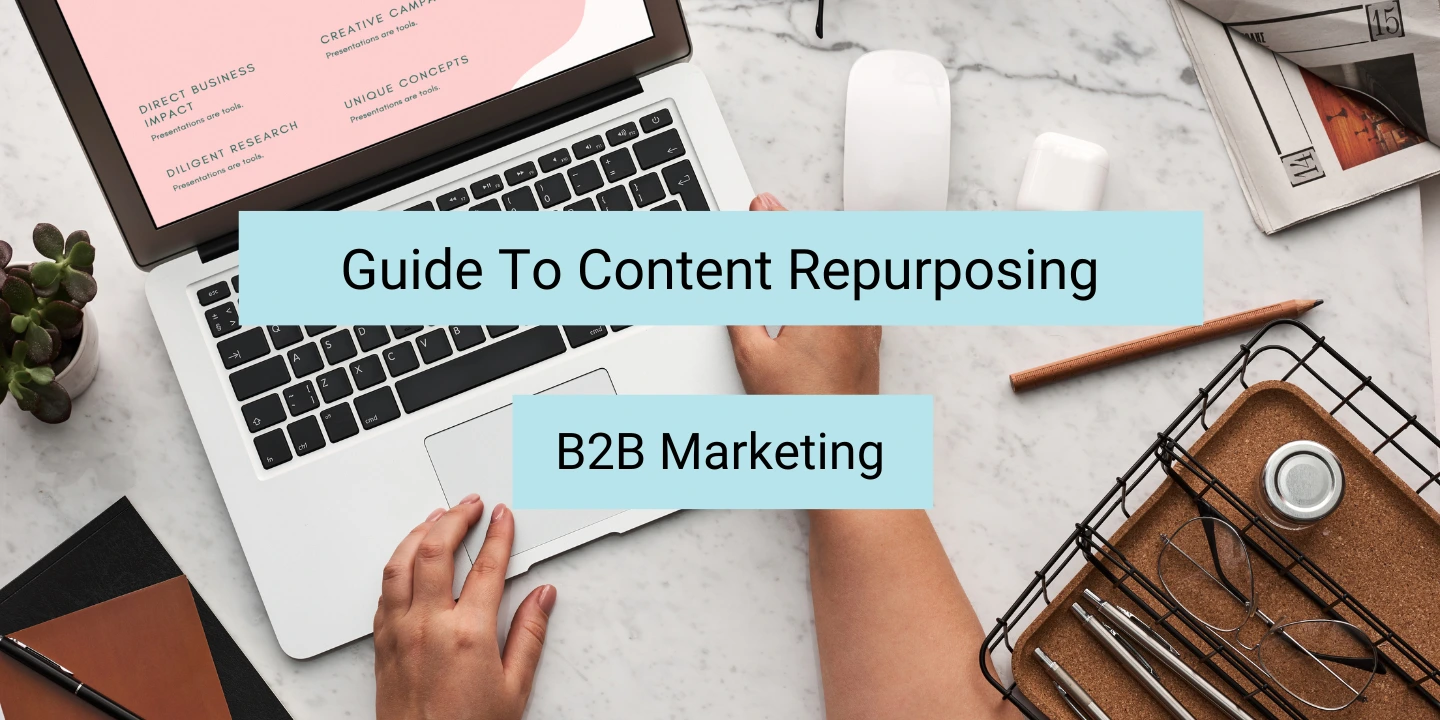Learn everything about content repurposing for better marketing.
According to a report, B2B marketers spend an average of 33 hours a week creating new content.
Conceptualizing, researching, developing, reviewing, editing, publishing and optimizing – so much goes into producing B2B content – and not to forget, distribution and syndication.
Content creation is a tedious, complex, and time-consuming process, and it’s only getting more complex to stand out in the noise.
But what if I said that every time you are required to fuel a marketing and sales funnel, you can actually make do with your existing content?
That’s where content repurposing comes into play.
What is B2B content repurposing?
Let’s be honest; you don’t have to create content every single day.
You already spend enough time making them in the first place, so why stop with just one post?
Repurpose them in different formats that apply to your audience and their platform. When you repurpose B2B content, you take something that already exists, put an exciting spin on it and use it in multiple formats. Repurposing gives your content new life and saves you time and resources.
16 to 20% of daily search queries on Google have never been seen before, where people express their interests, wants, and needs differently.
B2B marketers constantly look for new ways to stand out and create engaging content to meet these diverse demands – content repurposing is that one tactic that helps you do the same, and at a larger scale.
When should you do content repurposing?
If the content on your website doesn’t satisfy the buyer persona’s needs, it fails to keep them engaged.
A decline in engagement level on specific content or blog, an increase in website exit rate, or a drop in the CTA clicks and conversions are a few signs to notice in your content marketing strategy.
For instance, if you see an increase in organic traffic but a drop in click through rates, maybe your long form content needs to be more interactive and get repurposed in a playbook instead.
Why do you need content repurposing?
Repurposing content has many benefits, whether you are turning visual-based content into text or text to visual-based content. Here’s taking a look at why we love content repurposing at Contensify:
Saves time and resources
Creating high-quality content constantly is time-consuming and takes effort, especially if it’s premium content for lead magnets. If you repurpose, you can use your valuable time to maximize your investment in creating existing content as you don’t have to start from scratch.
Boosts content reach
You can reach a wider audience by repurposing content for another format. The audience that might not have seen the original content takes notice, which can drive more traffic to your website. Your text-based content may reach 80% of the audience, but the remaining 20% may wish to watch a video, view infographics, or listen to engaging podcasts instead of just reading an article. Hence, repurposing content in multiple formats allows you to reach a wider audience quickly.
Increases website SEO
Make your website authority for specific topics by creating several formats of exclusive content with similar keywords. Publishing repurposed content on different channels increases your odds of getting backlinks to your website to improve your ranking in search engines.
Scale your brand awareness
Scaling brand awareness is the number one goal for 50% of B2B marketers. Consistently publishing repurposed high-quality content is a sure shot and a cost-effective technique for businesses to build relationships with prospects and expand their brand authority. Repurposed content gives your old yet evergreen content a new lease of life and increases the content volume available on your website.
What content should you repurpose?
Now, you know the benefits of repurposing content, but how do you maximize the impact and effectiveness of the content you repurpose?
1. Top-performing content
To check this, go to your Google Analytics or Google Search Console and search for the content that has performed best in driving traffic to your site. Most social media platforms such as Twitter, Instagram, LinkedIn, and Facebook have a feature embedded in their analytics that tells you which posts are performing well. You can use the proven valuable content when repurposing content as your base topic. If it is effective in one format, it could be ideal to adapt to a different format and distribution channel.
2. Evergreen content
This has to be the content that provides value to prospects and customers over the long term. Irrespective of trending topics or buzzing news, look for content that doesn’t cease to be relevant even after a certain period. Repurposing this kind of content into appropriate formats will prove valuable to your brand authority.
3. White papers
A white paper is a premium piece of content that you create and takes significant time and resources. Hence, it is imperative to maximize your investment by adapting these into different content formats.
Using the white paper to create a cluster of blog posts on a particular topic can be an excellent SEO strategy. Repurpose a white paper into a series of blog posts by splitting the entire content of the white paper among different blog posts and develop on those ideas.
Conclude each blog post with a call to action that allows prospects to download the white paper. You can create a series of infographics using all the statistics from the information in a white paper. Use these for posting on social media because infographics drive traffic to your website and establish your brand as an authority for a specific niche.
4. Webinar content
B2B webinars are an excellent way to provide expert insight and deliver engaging content to your target audience because they generate leads even long after it is originally published.
Creating a transcript of the video and utilizing it as the basis for a blog post is the most common and simple way to repurpose a webinar. Use the voice dictation feature in Google Docs to do this while recording, and also, various tools are available online to transcribe video files automatically. You can replicate the webinar transcript or use the popular part of it and elaborately create blog posts about the same.
Another format to create engagement on social media is short reels which are often widely shared online. If you have a pre-recorded webinar, you can edit the video files to make reels for social media, and don’t forget to link to the webinar page. If the webinar has a Q&A section or any other feedback system, you can repurpose that to answer further queries and provide updated info to readers.
What are the best formats for content repurposing?
While there’s no one-size-fits-all approach to content repurposing or the formats you make use of, there are a few that always work well and can be used with ease for marketing, sales and support functions at an organization.
1. Blogs
Blog posts are the most common format when it comes to content repurposing. If you notice a topic or a section of an existing content piece doing well, create an independent blog out of the same to add more depth to it. This also helps you build out better interlinks on your website, boosting your SEO efforts.
2. Infographics
Visual data is catchy and captures your target audience’s attention. You already have the text format, so all you need to do is to transform the same into a visual format. For example, if your text post contains several statistics, using these figures to create an infographic is a great way to repurpose it. This kind of visual information makes it much more engaging and easier for your audience to understand. Once the infographic is incorporated into the original blog post, it can be shared on one or more social media posts.
3. Social media posts
Many blog posts can be broken down into small bits and used as social media posts. Once these posts are ready, you can link them back to the original blog post to generate engagement further and drive traffic to your website. Experiment with different formats here as well – image posts, carousels, short videos, Instagram Reels and others.
4. Videos
94% of marketers say that videos have been helpful to the audience to increase the understanding of their product or service, and 86% say that the videos help them generate leads. Recreating your blog posts into videos will boost your content discovery considerably – channels like YouTube, Vimeo and others are some of the most important content engines. Instead of just reading your blog posts on camera, use graphics or images in your original blog post to make it an engaging audio-visual medium.
5. Podcasts
Most people don’t have time or patience to read blogs or watch videos, but you can listen to a podcast anytime on the go. Podcasts are an increasingly popular format as it’s an exciting and engaging way to share knowledge with the world. If you have an audience that may listen to these, you can look at repurposing blog posts into podcast episodes. Creating a podcast is easier than making a video because it is a purely audio format and is highly beneficial, especially for B2B marketing content, as it can save marketers valuable time.
Now we know content repurposing has a lot of moving pieces. That’s why we’ve created a content repurposing checklist for you.
Content Repurposing Checklist
Content repurposing should be treated like an independent optimization and marketing strategy. The idea is to keep things streamlined, and here are some of the steps you can follow for the same:
1. Lay down your goals and objectives
Every action has a purpose, and repurposing content is no exception. As a marketer, you must ask yourself, “what is my aim with repurposing?” Is it to increase website traffic or amp up your socials? Yes, repurposing has many benefits, such as saving time for the content team and giving your audience a chance to view your content in multiple formats but make sure you have a set objective in mind and track the right KPIs.
2. Track analytics and take notes
Now that you have set your goals, it’s time to get to work. Evaluate the current analytics of your content to identify what works and which pieces of content need a revamp. Perhaps your blogs are getting users to visit your website, but you aren’t getting the expected conversions. Modifying and distributing your content in different formats can pique interest because you never know what might resonate with your audience better.
Firstly, categorize the content that performs well over a short period or performs steadily over a more extended period. Keep a tab on your site analytics to check for posts that have performed the best over the past month and year. Look for your highest clicked article for the year, and also, if any of your old articles are still getting traffic, it’s ready to be repurposed and republished.
3. Create a repurposing strategy
Every B2B company desires the best results from its content, which would be difficult to achieve without a well-thought-out strategy. This should be the first step toward the process of repurposing; otherwise, you’ll be wasting the time and intellectual effort of your entire team.
Multiple formats, such as blog posts, videos, and podcasts, are standard in specialized industries. Once you’ve zeroed in on a specific format, all you have to do is ideate your evergreen content, audit them, and repurpose them. Base your repurposing strategy by checking if your highest-performing blog post can be turned into short videos, infographics, podcasts, or a webinar on the subject matter.
Suppose you have a video on YouTube which is 20 minutes long. Would you just take that entire video and paste it on Instagram? No, you’ll have to split the video into pieces. You can break the video into 10-minute videos, with two engaging and informative videos from one. So, this way, by keeping it simple and crisp by highlighting the main insights, your long video content can be repurposed. Similarly, you can recycle your 1000-1500-word blog post into a Twitter thread, two LinkedIn posts, a Quora question or answer, and an Instagram reel.
4. Repurpose with a direction
Repurposing B2B content without any purpose is a total waste of time and effort. Although your repurposed content is valuable, it’s a complete waste if it doesn’t achieve the goal you’re looking for. So to make it foolproof, ensure that the content is up to date, error-free, and highly informative. You can combine related content with adding more value and links or backlinks to cross-promote. Keep reviewing your content from time to time and look for chances to dive deeper into a particular topic or create entirely new content.
Conclusion
Repurposing content does not mean you should stop creating new content.
But using your existing content, which you’ve created with so much effort, can save you time, increase your website SEO, and improve the reach of your content. It is an effective way to make the best use of the resources involved in content creation in the first place.
The last thing you want to see while reviewing metrics is a dip in organic traffic that can come from industry changes, the quantity and quality of new content you’re creating, or how applicable your older content is. So, sometimes, all you need to do is a little recycling and repurposing of your content to keep your audience engaged.
Struggling to extend the runway of your content?
Reach out to me or my team at Contensify to simplify B2B content marketing for you.





